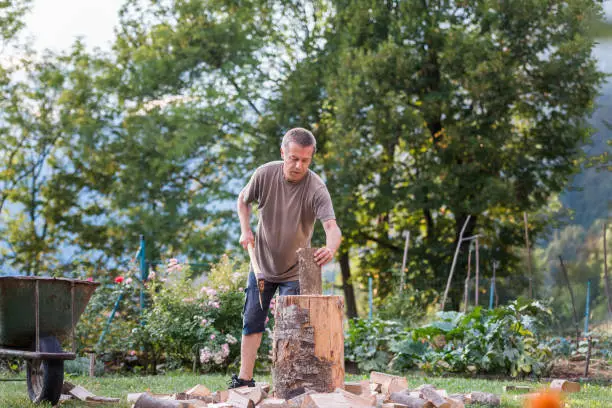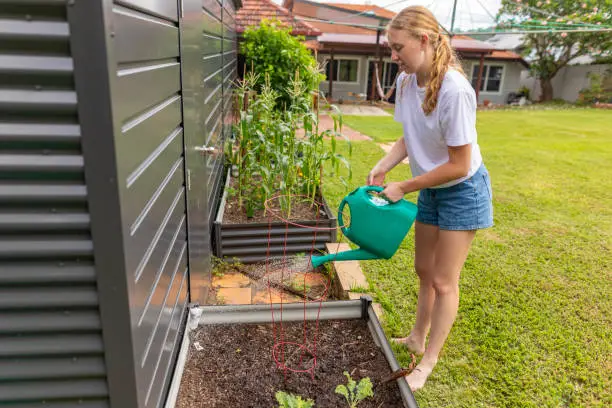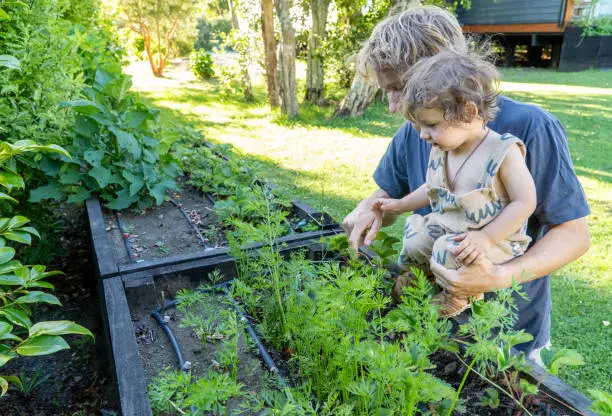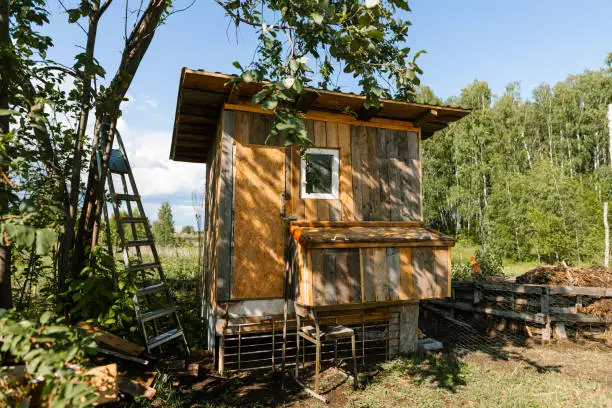Even though winter is a time to rest, fruit trees need care—pruning matters. Dead or unhealthy branches should be trimmed to help the tree focus on spring development. Consider it a backyard homesteading tree haircut before a significant celebration. Cut cleanly with sharp tools and remove limbs that cross or rub.
Another winter chore? Dormant oil spray. This controls wintering aphids and mites. It works best above freezing but before buds swell. Imagine it shielding your tree from microscopic pests.
All systems go in spring! Buds swell, leaves unfurl, and blossoms bloom. Early spring fertilization gives trees the nutrients they need for healthy development. Choose a balanced or fruit tree fertilizer.
Pest management is essential now. If ignored, leaf holes, discolored scars, and microscopic insects can cause severe problems. Organic sprays like neem oil perform well without harming beneficial insects.
Spring requires more watering. Deep watering causes roots to grow down, making them more tolerant to dry spells. A weekly soak works if you have sandy soil that drains quickly.
Summer has its problems and advantages. Thinning fruit seems counterintuitive—why throw away wonderful apples or peaches? I promise, less is more here. Thinning increases fruit size and decreases branch strain.
Mulching is another summer must-do. A thick layer of organic mulch retains moisture, suppresses weeds, and decomposes to replenish soil nutrients.
Regular fruit harvesting protects branches from overloading and snapping, a painful sight after months of effort! Plus, regular plucking boosts fruit output.
Autumn cleanup and preparation for next year’s harvest. Leaves should be raked up, composted, or disposed of if they are diseased since they can shelter pests throughout winter.
Applying a final fertilizer in late fall builds nutrient reserves for early spring growth next year.
Remember irrigation systems! Before winter, examine drip lines for obstructions or leaks; frozen water can harm without attention.

Grafting is like tree matchmaking! Sap flow encourages new unions between scion wood (the desired variety) and rootstock (the hardy base) in late winter or early spring, the ideal grafting season. Grafting offers unlimited options for creating multi-fruit “Franken-trees” or propagating favored types onto hardier roots!
Have you experienced espaliering? Training trees against flat structures like walls or fences with careful trimming over several years saves space and creates fruit-laden living art!
Although winter is a rest, fruit trees need care—pruning matters. Trim dead or diseased branches to help the tree develop in spring. Consider a backyard homesteading tree trim before a big event. Remove rubbing limbs and cut cleanly with sharp tools.
Another winter chore? Dormant oil spray. This manages wintering mites and aphids. It works best above freezing but before buds swell. Imagine it protecting your tree from little pests.
All systems go in spring! Buds grow, leaves unfold, and flowers bloom. Early spring fertilization feeds trees for good growth. Choose balanced or fruit tree fertilizer.
Now, pest control is crucial. Leaf holes, reddish blotches, and microscopic insects can cause significant issues if overlooked. Organic sprays like neem oil work without harming beneficial insects.
Spring needs additional water. Deep watering deepens roots, making them drought-tolerant. Except for sandy soil that drains quickly, weekly soaks work.
Summer has pros and cons. Thinning fruit seems counterintuitive—why waste good apples or peaches? I promise less is more. Thinning boosts fruit size and reduces branch strain.

Mulching is another summer must-do. Thick organic mulch preserves moisture, inhibits weeds, and decomposes to replenish soil nutrients.
Harvesting fruit regularly prevents branches from overloading and snapping, a sad sight after months of work! Plus, consistent plucking increases fruit yield.
Fall cleaning for next year’s crop. Diseased leaves should be scraped up, composted, or disposed of since they hide pests in winter.
Final fertilization in late fall stores nutrients for early spring growth.
Remember irrigation! Check drip pipes for leaks or clogs before winter; frozen water can damage.
Grafting is tree matching! Sap flow promotes new unions between scion wood (the desired variety) and rootstock (the hardy base) in late winter or early spring, the ideal grafting season. Grafting allows endless creation of multi-fruit “Franken-trees” or hardier-rooted favorite varieties!
Mastering Fruit Tree Grafting in Backyard Homesteading
Consider turning your backyard into a mini-orchard. Grafting leads to fruit tree paradise. Like plant matching, it combines the most outstanding qualities of two trees into one supertree. Let’s start with some grafting procedures to make you the neighborhood fruit expert.
Whip and Tongue Graft: The Old Trusty
This method is grafting a Swiss Army knife. This multipurpose tool works well on young trees with thin branches. Imagine cutting wood instead of bread. Pair the rootstock (base plant) and scion (graft branch) cuts. Put them together like puzzles.
Start with a sharp knife—no butter knives! Cut both pieces an inch long slanted. The tricky step is cutting a little tongue on each piece. It snugs them together. Secure them with grafting tape or rubber bands and wax to prevent dampness.
Whip and tongue grafts are vital because they have a lot of surface area for cambium layers to join. If done appropriately, they’re nearly infallible.
When size matters, cleft graft
Do you have an older tree with thicker branches? Cleft grafting is preferred. For firewood, think of more minor, more precise log splitting.
Select a healthy rootstock branch and see it cleanly. Imagine Moses crossing the Red Sea with wood instead of water by splitting it with a chisel or keen knife.
Sharpen your pencil-thick scion wood into a wedge. Put this wedge into the rootstock split to align the cambium layers.
Tape or twine everything and seal exposed portions with wax or tree sealant to avoid drying or infection.
Bud Grafting: The Sneaky Method
Bud grafting is like a garden undercover agent—effective but discreet—swap buds instead of complete branches.
Choose a healthy bud from your selected type in late summer when the bark peels easily. Cut it and a little shield-shaped piece of bark behind it like an apple slice with some skin left.
How to Sneak Bud Grafting
Like a garden undercover agent, bud grafting is discreet and effective. Replace branches with buds.
Select a healthy bud from your type in late summer when the bark peels easily. Cut it and a shield-shaped piece of bark behind it like an apple slice with some skin.
Put this bud and shield behind a T-shaped rootstock bark cut—grafting tape it, exposing the bud. The bud will take a few weeks, and you can cut back the rootstock above it to promote growth.
The Sneaky Side Veneer Graft
This strategy is excellent for diversifying established trees. Cut a downward-sloping rootstock slit. Carve a similar scion slope. Put the scion in the rootstock cut and tape it.
Transformation of Mature Trees
Make older trees multi-fruit wonders. Major limbs and various cleft graft scions were cut off. Successful integration requires cambium layer alignment.





Leave a Reply
You must be logged in to post a comment.